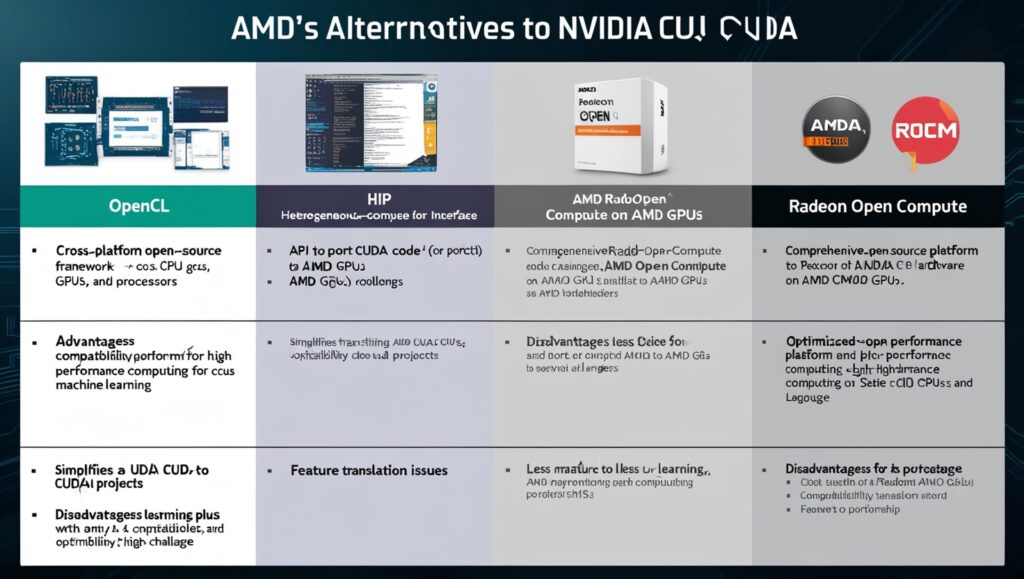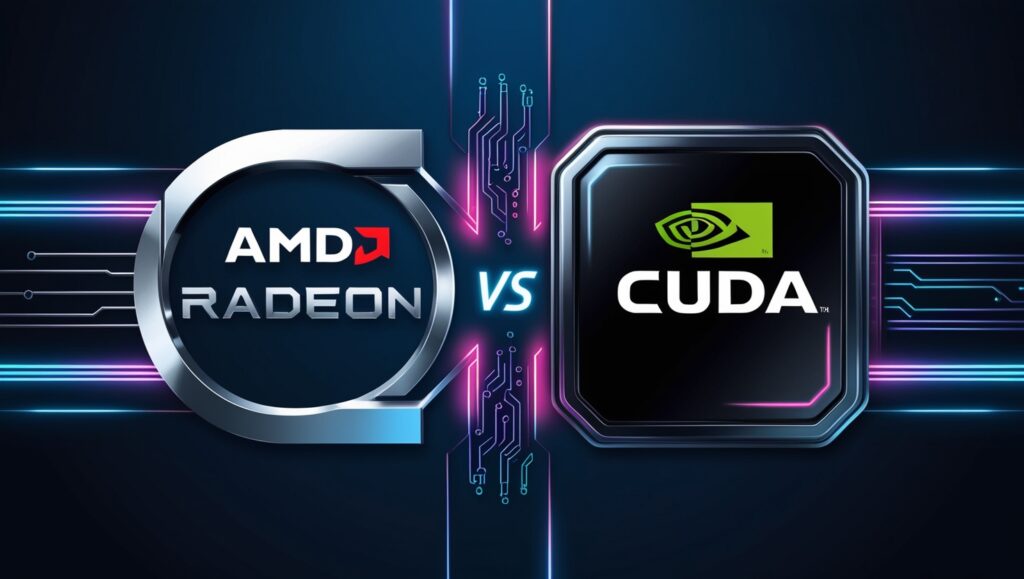NVIDIA CUDA is a platform that is commonly utilized for purposes such as intelligence (AI) deep learning applications and scientific computations. Its resources and assistance have positioned it as the preferred option for developers in the field. AMD graphics. Nvidia’s CUDA technology. AMD graphics cards cannot directly utilize CUDA since it is exclusive to NVIDIA GPUs resulting in increased complexity when attempting CUDA-based tasks, with AMD hardware without modifications.
Developers now have choices as new tools allow CUDA programs to operate on AMD GPUs. AMDs. Remedies. AMD developed the HIP tool to enable the conversion of CUDA code and positioned ROCM as a platform for high-performance computing in competition with NVIDIA.

AMD’s Alternatives to NVIDIA CUDA
- Exploring GPU Computing Technologies
- OpenCL is also known as Open Computing Language.
- A framework for computing that is source and compatible, across different platforms.
Benefits
- Runs on types of processors such as CPUs and GPUs
- Works well with a variety of hardware systems
Challenges
- Using and programming this can be quite complicated.
- It can be challenging to tailor optimization, for hardware configurations.
- Ideal Applications; Perfect, for projects that require compatibility or diverse systems.
- HIP (which stands for Heterogeneous compute Interface, for Portability)
- An API has been developed to assist in converting CUDA code for use on AMD GPUs.
Pros
- It simplifies the process of shifting CUDA-based projects to AMD GPUs.
- Reduces the need to modify existing CUDA code.
Downsides
- Some aspects of CUDA functionality may not be completely transferred over.
- Great, for developers looking to transition their CUDA projects to AMD platforms.
- ROC M, also known as Radeon Open Compute.
- An open-source platform that prioritizes high-performance computing specifically designed for AMD GPUs.
Benefits
- Designed to work on AMD devices.
- Intense attention, toward the utilization of machine learning, in applications.
Challenges
- Not as. As commonly backed as CUDA.
Ideal Applications
- Perfect, for conducting machine learning and high-performance computing (HPC) activities using AMD GPUs.
Comparative Analysis of GPU Architectures

The structure of AMD Radeon graphics processing unit (GPU) design.
- In its design, it depends on stream processors organized into Compute Units (known as CUs) to handle data in parallel.
- Advantages include its proficiency in vector-based tasks such as simulations and intricate graphic rendering work.
- The design of NVIDIAs CUDA Core architecture.
- The design incorporates processors in Streaming Multiprocessors (SMs) allowing for parallelism.
- Optimized using the CUDA Toolkit with libraries and tools designed for high-performance tasks such, as intelligence and deep learning applications.
- Open source compatibility layers, for software applications.
- Let’s talk about OpenCL.
- An adaptable structure that functions on processing units like CPUs and GPUs as well as different platforms—a great fit, for diverse systems.
AMDs ROCK platform
- Transforming CUDA code into HIP allows it to be compatible with AMD GPUs, for platform functionality.
- I’m not sure what “sludge” means. Can you provide context? Clarify your message.
- Allows CUDA applications to run on Intel GPUs to broaden the range of GPU compatibility choices.
Direct X 12
- An in-demand platform used for gaming and graphics rendering that offers capabilities for boosting GPU performance in programs.
Development and Programming on Radeon GPUs

Harness the power of ROCK, for GPU computing
- Essential Characteristics
- They are crafted to excel in tasks such as high-performance computing and the realms of intelligence and machine learning.
- Efficient computations are made possible with the support of libraries, like BLAS (Basic Linear Algebra Subprograms ) and FFT (Fast Fourier Transform).
- Recent Advancements
- Enhanced compatibility and performance have positioned ROCM as an option for workloads.
- Improved assistance, for developing applications that work across platforms and are compatible with used frameworks.
- Developing applications, for platforms
- Transition Procedure
- Transforms CUDA code, to HIP code for compatibility, with AMD GPUs.
Offers resources such as
- Automates the process of converting CUDA source code into HIPPIFY
- HIPPC is a tool designed for running HIP programs on AMD hardware.
- Support, for libraries and frameworks
- ROC Programming libraries
- hip FFT provide effective calculations for Fourier transforms.
- Framework Suitability
- It is designed to work with known machine learning platforms such as PyTorch and Tensor Flow to easily fit into your current processes.

6. Frequently Asked Questions
What was AMD’s alternative to CUDA for parallel computing?
AMD has ROCm (for Radeon Open Compute platform) as their equivalent of CUDA. ROCm, is a high-performance computing platform of open-source software for AMD GPUs that allows developers to write parallel applications.
What is AMD’s ROCm? How does it compare against Nvidia’s CUDA?
ROCm is an open-source framework used on AMD GPUs, whereas CUDA is a proprietary platform dedicated to NVIDIA GPUs. 5. ROCm – which stands for Radeon Open Compute – was designed to provide an open ecosystem and a focused set of cross-platform tools for general parallel computing offering the functionality of CUDA.
Can the PyTorch be utilized with the AMD GPU for machine learning purposes?
Yes, AMD GPUs can be used with PyTorch. This usually involves the use of the ROCm platform as well as the HIP (Heterogeneous-compute Interface for Portability) library that converts CUDA-based operations for running on AMD GPUs.
What is OpenCL and how does it fit into the GPU computing ecosystem for AMD?
OpenCL is Apple’s cross-platform programming model for running applications on different processors (including AMD GPUs). It enables general-purpose GPU computing within the greater AMD ecosystem while also complementing ROCm for developers.
Are applications developed under CUDA compatible with AMD’s ROCm?
Yes, the ROCm stack enables running CUDA applications on AMD GPUs. Top-level awareness is important, tools such as HIP, and implementations such as ZLUDA keep compatibility, thereby allowing CUDA codes to port or run directly on AMD hardware.
What does it compare to CUDA cores in terms of GPU features?
AMD’s GPU equivalent of NVIDIA’s CUDA cores are called “stream processors.” They take care of parallel computations and provide efficiency for high-performance utilities. Both architectures target strong parallel computing performance across multiple use cases.



